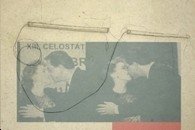Jiri Kovanda
dal 24/11/2009 al 15/1/2010
Segnalato da
24/11/2009
Jiri Kovanda
Krobath Wimmer, Wien
The works on show includes a series of Playmate photos where the women's faces and private parts have been covered with coloured censor bars. Kovanda also uses stills from films, inserting a vertical bar across the image so as to disrupt the encounter between man and woman. Kovanda's work with the visible and the hidden, with fragments of images and text combines popular iconographic symbols familiar from advertisements with political messages.

Jirí Kovanda is one of the generation of Czech artists whose works from the 1970s onwards have included a performative element that is conveyed via various media. This is visible in Kovanda‘s actions in public areas in Prague, in the found pieces of wood that he shapes into new objects, and in his collages, whose creation is characterised by a certain dynamism. Ever since his earliest works, Kovanda has experimented with various materials and techniques at the same time, and his extensive collection of collages of the past 30 years can be regarded as a distinct group.
Snippets of images from newspapers, advertisements, or the Playmate section are affixed to various sheets of coloured paper and sometimes annotated, thus creating various contexts for interpretation. Often, Kovanda uses square images of body parts, both exposed and covered, in a reference to Kasimir Malevich‘s iconographic symbolism. One of his most minimalist collages of this type features a small black square on a grey background – below we read: “Hitlerův knír“ (Hitler‘s Moustache). Another collage shows a glittering black square with a purple frame on dark background. This one, however, has no textual reference. Yet another incorporates parts of an advertisement for Calvin Klein‘s “Obsession“ fragrance for men that features a famous photograph by Bruce Weber; we see only a square-shaped detail of the triceps of the man who is carrying a woman over his shoulder. In a number of other collages that appear as cover designs for the book Moby Dick (Bílá Velryba), the square makes a reappearance in various forms. Sometimes deconstructed and modified, it hints at various ways of portraying perspective, something which can also be found in numerous different incarnations in Malevich‘s works.
The group includes a series of Playmate photos where the women‘s faces and private parts have been covered with coloured censor bars. Kovanda also uses stills from films, inserting a vertical bar across the image so as to disrupt the encounter between man and woman. Ironic comments like “Pornografie je neškodná“ (Pornography is Harmless) are added to images of innocent kissing scenes, while on an ad for women‘s jeans Kovanda places a trapezium-shaped piece of patterned paper over the crotch (a reference to VALIE EXPORT‘s “Action Pants: Genital Panic“ from 1969). In another collage, a square of hashed pencil lines on a wallpaper background engenders immediate associations with a patch of pubic hair.
Kovanda‘s work with the visible and the hidden, with fragments of images and text combines popular iconographic symbols familiar from advertisements with political messages. Take, for example the image of a Muslim woman giving thanks to God for the ceasefire in Beirut. Kovanda‘s ironic approach manipulates these images of women as found in the media via various montage forms and techniques. References to changing photographic policies are manifested in the empty spaces and in the highly charged gaps between the image, pattern and lines of text.
Text: Walter Seidl (English translation: Mandana Taban)
Opening 25 November 2009
Krobath Wimmer
Eschenbachgasse 9, Wien



